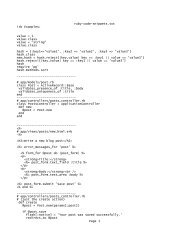Java Workflow Tooling Comparison of Business Process Metamodels
Java Workflow Tooling Comparison of Business Process Metamodels
Java Workflow Tooling Comparison of Business Process Metamodels
You also want an ePaper? Increase the reach of your titles
YUMPU automatically turns print PDFs into web optimized ePapers that Google loves.
Figure 6: JWT – processes<br />
All processes modelled with Eclipse JWT are Activities. An activity is a PackageableElement<br />
and can therefore be structured in packages. An Activity is a subclass <strong>of</strong> Scope which includes<br />
all elements in a graphical model. Examples for those elements are ActivityNodes and<br />
ActivityEdges. One example for an ActivityNode is an Action which is executable (subclass <strong>of</strong><br />
ExecutableNode) and has a name and optional an icon (subclass <strong>of</strong> NamedElement). A<br />
StructuredActivityNode contains as an own scope itself ActivityNodes and ActivityEdges, but<br />
is itself executable from other nodes, too. Each ActivityEdge connects two ActivityNodes and<br />
might be constrained with a Guard which has a textualDescription and a more<br />
detailedDescription which can be simple Boolean terms (using the OperationType) or more<br />
complex terms connected through BooleanConnectors. Using the parameters <strong>of</strong> Activity<br />
(totalExecutionTime) and <strong>of</strong> all Actions (targetExecutionTime) one can simulate the duration<br />
<strong>of</strong> the process and compare it with the predefined value.<br />
Figure 7: JWT – control nodes<br />
To model the flow <strong>of</strong> several ExecutableNodes one can use ControlNodes. To model the start<br />
or finish <strong>of</strong> a process the InitialNode and FinalNode can be applied. To model parallel process

















